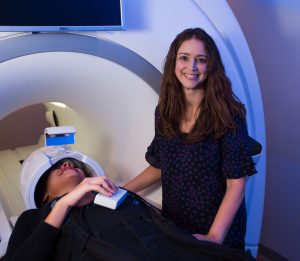Angela Laird, Professor in Physics, is committed to finding the answers to two questions – “How does this work?” and “What does this mean?”
Laird, a cognitive neuroscientist and medical physicist, is the Director of FIU’s Center for Imaging Science (CIS), hired in 2012 as part of a push to grow FIU’s neuroscience research. The CIS is an interdisciplinary research center that hosts a 3.0 T Siemens MAGNETOM Prisma MRI, and is a research destination for many in the Greater Miami community, especially for pediatric neuroimaging studies.
The process of getting the MRI scanner on campus was completed in 2016, and Laird was instrumental in all steps of the project, from planning to construction to installation. She was determined to create a facility that was family-driven and fit FIU’s mission. Instead of a cold and sterile feel, she wanted the environment to be warm, friendly, and inviting, and great attention was paid to detail and aesthetics.
“Having an MRI can be intimidating, especially to a child. We didn’t want them to feel anxious about the big scary machine, we wanted them to feel comfortable and safe. I’m proud of how we designed the facility,” she says. She considers herself a steward of the university, and customer service is an important aspect of that mentality. “Our goal is to have people realize that this is a good endeavor that will benefit many and we hope our research participants will be interested in returning for future studies.”
Indeed, Laird is interested in endeavors that shine light on areas which haven’t received much attention in the past. “Many studies in human brain mapping have only recruited research participants who are right-handed, Caucasian, and male. My goal is to improve representation across all categories, yielding scientific results that are grounded in a diverse sample and more representative of all individuals,” she says.
As a researcher in South Florida, Laird is eager to showcase results on Latinos and Hispanic Americans. She recently wrapped up data collection on a four-year study that examined changes in FIU students’ problem-solving skills before and after taking an introductory physics course. Her emphasis now is on publishing the neuroimaging findings from that study, including how male and female students differ in learning physics, as well as how they manage their anxiety related to science and math topics.
She’s also launching a new research study into how the brain responds to the cognitive and emotional changes experienced by postpartum mothers, an area that is understudied in the scientific literature. “As a mom of three children, I’m privileged to be able to do work that means something to me on a personal level,” Laird says.
Laird is a physicist by training. She earned her Ph.D. in Physics from the University of Wisconsin-Madison, where she used physics to solve problems in medicine (she completed her postdoctoral research at a radiology department). At the time, functional magnetic resonance imaging (fMRI) technology was less than a decade old, and research was being conducted into analysis and best practices.
The interdisciplinary nature of the cognitive neuroscience field is exciting, according to Laird. “’Diversity’ is a multi-purpose word. I’m proud to mentor such a diverse group at students at FIU from both the Physics and Psychology departments. Individuals with different backgrounds bring different perspectives, and we need new ideas and creative solutions in science. We need problem-solvers, people who wonder what will happen if we look at things in new and different ways.” Her own creativity and work are certainly setting a great example for future generations of cognitive neuroscientists.
FIU Women in Research is a regular feature of ADVANCE News that examines the impressive work female faculty members are doing at the university.

